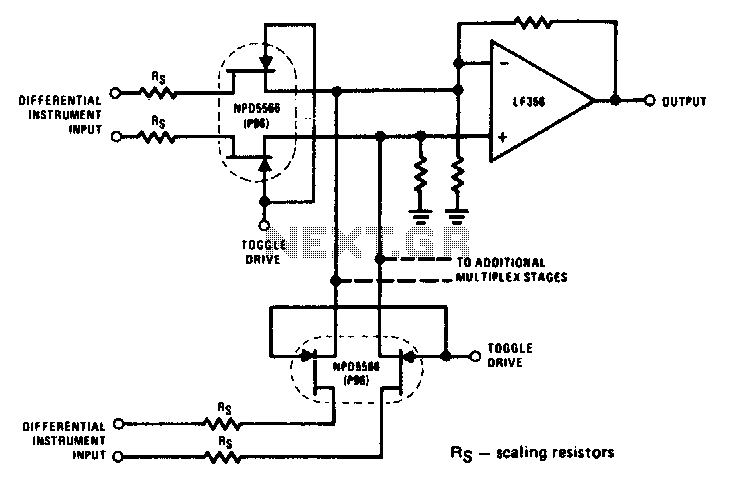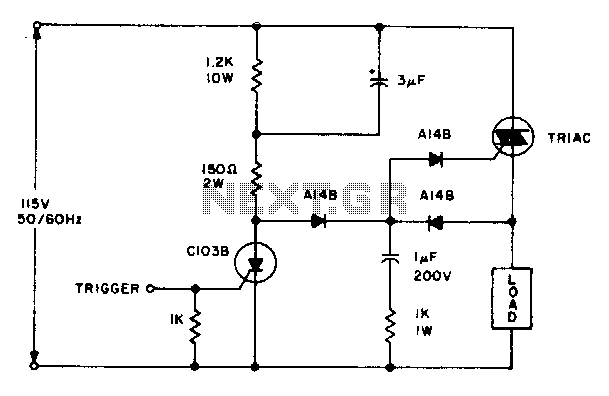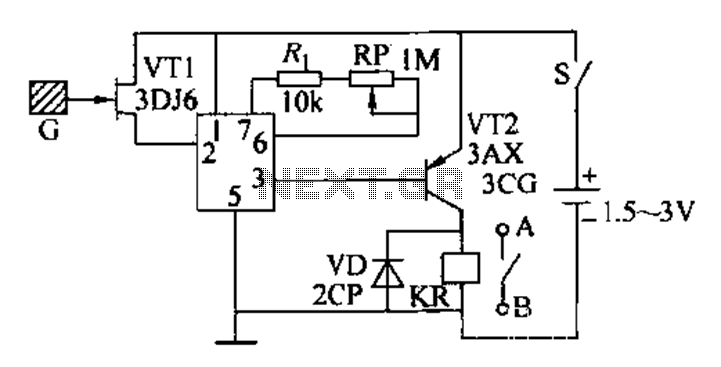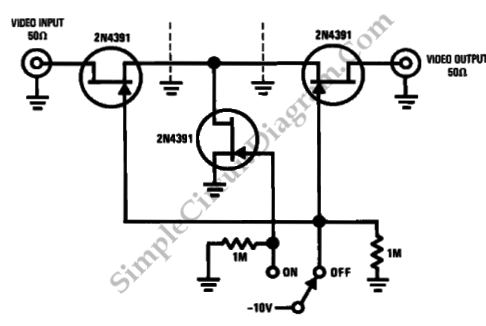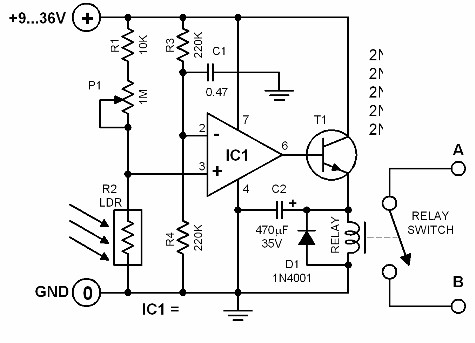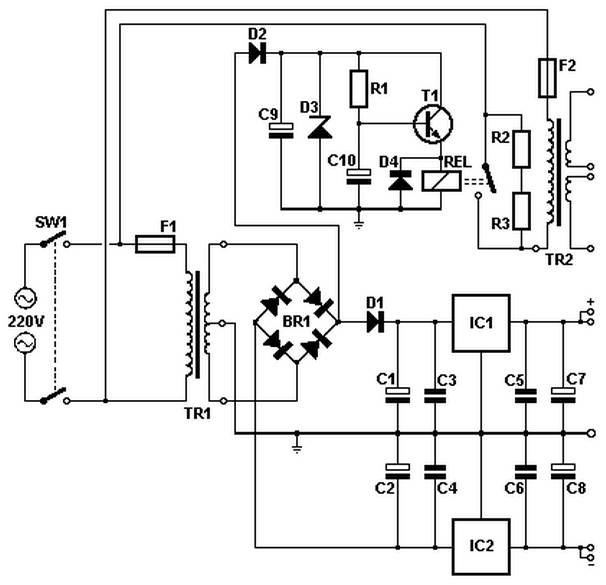
RC (Remote Control) Switch
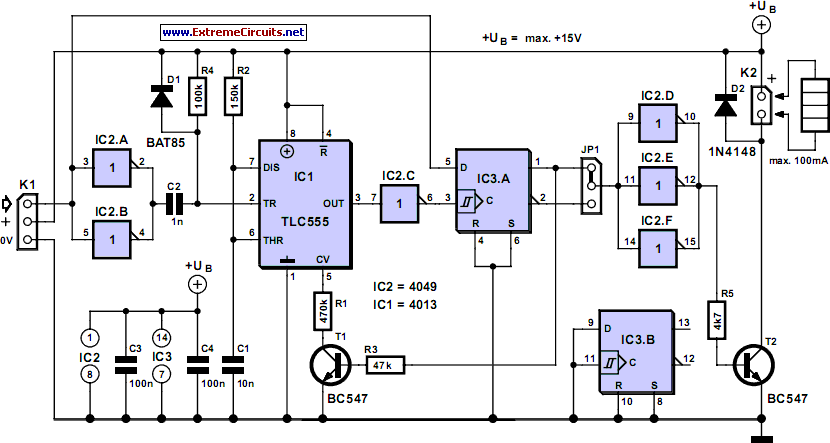
It is sometimes necessary for a remote control (RC) model to incorporate switching functionality. Examples include lights on a model boat or the retraction of an airplane's landing gear. A common solution utilizes a servo to operate the switch. There are also separate modules available that may or may not include a relay. A device with such functionality is well-suited for DIY construction. The schematic demonstrates that it can be easily implemented with a few standard components. The servo signal, which consists of pulses ranging from 1 to 2 milliseconds in duration based on the desired position, enters the circuit through pin 1 of connector K1. Two buffers from IC2 provide the necessary buffering, after which the signal is differentiated by capacitor C2. This differentiation results in a negative start signal presented to pin 2 of IC1 at each rising edge. Diode D1 and resistor R4 ensure that the voltage at pin 2 of IC2 does not exceed a certain level at the falling edge. IC1 (TLC555) is a reliable CMOS version of the classic timer. While a standard version like the NE555 can be used, it draws higher current, which is undesirable for low-power models. The 555 timer is configured as a monostable multivibrator, with the pulse duration determined by the R2/C1 combination. Reducing the voltage on pin 5 also influences the pulse duration. In this circuit, the output pulse from IC1 lasts just over 1.5 milliseconds when transistor T1 is not conducting. When T1 conducts, the pulse duration is slightly shorter than 1.5 milliseconds. The purpose of this will be clarified later. The fixed-length pulse from IC1 is presented to the clock input of a D flip-flop via IC2.C. Consequently, the flip-flop retains the state of the input (the servo signal). As a result, when the servo pulse exceeds the 555 output pulse duration, output Q will be high; otherwise, it will be low. In practice, it is possible for the servo signal to be nearly the same length as the output from the 555 timer, which could lead to output chatter—where the output fluctuates between high and low. To mitigate this chatter, feedback is introduced through resistors R1, R3, and transistor T1. This feedback ensures that once the flip-flop determines the servo pulse is longer than the 555 pulse (indicated by output Q being high), the pulse duration from the 555 is slightly reduced. Consequently, the servo signal must be shortened significantly before it becomes less than the 555 pulse. When this occurs, T1 ceases conduction, and the monostable duration increases. The servo pulse must then be longer by a significant margin before the flip-flop changes state again. This principle is known as hysteresis. Jumper JP1 allows selection between normal or inverted output signals. Buffers IC2.D to IC2.F, along with resistor R5, drive output transistor T2, which controls the output. It is important to note that the load may draw a maximum current of 100 mA. Diode D2 has been included to enable switching of inductive loads, such as electrically operated pneumatic valves.
The described circuit employs a TLC555 timer configured as a monostable multivibrator to control the switching mechanism for an RC model. The input servo signal, which is variable in duration, is conditioned through buffering and differentiation to create a clean trigger pulse for the timer. The timer's output pulse duration is adjustable based on external resistors and capacitors, allowing for fine-tuning of the switching event. The integration of a D flip-flop ensures stable output even in the presence of signal variations, while the hysteresis feedback mechanism prevents rapid toggling of the output state, enhancing reliability. The circuit's design accommodates various output configurations through jumper selection, facilitating adaptability to different applications. Additionally, the inclusion of a protective diode for inductive loads ensures that the circuit can safely control devices such as pneumatic valves, making it versatile for various RC model applications. Overall, this schematic represents an efficient and reliable solution for implementing switching functions in remote control models.It is sometimes necessary for an RC (remote control) model to contain some kind of switching functionality. Some things that come to mind are lights on a model boat, or the folding away of the undercarriage of an aeroplane, etc.
A standard solution employs a servo, which then actually operates the switch. Separate modules are also available, which may or may not contain a relay. A device with such functionality is eminently suitable for building yourself. The schematic shows that it can be easily realised with a few standard components. The servo signal, which consists of pulses from 1 to 2 ms duration, depending on the desired position, enters the circuit via pin 1 of connector K1. Two buffers from IC2 provide the necessary buffering after which the signal is differentiated by C2. This has the effect that at each rising edge a negative start signal is presented to pin 2 of IC1. D1 and R4 make sure that at the falling edge the voltage at pin 2 of IC2 does not become too high. IC1 (TLC555) is an old faithful in a CMOS version. A standard version (such as the NE555) works just as well, but this IC draws an unnecessarily high current, while we strive to keep the current consumption as low as possible in the model.
The aforementioned 555 is configured as a one-shot. The pulse-duration depends on the combination of R2/C1. Lowering the voltage on pin 5 also affects the time. This results in reducing the length of the pulse. In this circuit the pulse at the output of IC will last just over 1. 5 ms when T1 does not conduct. When T1 does conduct, the duration will be a little shorter than 1. 5 ms. We will explain the purpose of this a little later on. Via IC2. C, the fixed-length pulse is, presented to the clock input of a D-flip-flop. As a consequence, the flip-flip will remember the state of the input (servo signal). The result is that when the servo-pulse is longer than the pulse form the 555, output Q will be high, otherwise the output will be low. It is possible, in practice, that the servo signal is nearly the same length as the output from the 555.
A small amount of variation in the servo signal could therefore easily cause the output to chatter`, that is, the output could be high at one time and low the next. To prevent this chatter there is feedback in the form of R1, R3 and T1. This circuit makes sure that when the flip-flip has decided that the servo-pulse is longer than the 555`s pulse (and signals this by making output Q high), the pulse duration from the 555 is made a little shorter.
The length of the servo-signal will now have to be reduced by a reasonable amount before the servo-pulse becomes shorter than the 555`s pulse. The moment this happens, T1 will stop conducting and the mono-stable time will become a little longer.
The servo-pulse will now have to be longer by a reasonable amount before the flip-flip changes back again. This principle is called hysteresis. Jumper JP1 lets you choose between the normal or inverted output signals. Buffers IC2. D through to IC2. F together with R5 drive output transistor T2, which in turn drives the output. Note that the load may draw a maximum current of 100 mA. Diode D2 has been added so that inductive loads can be switched as well (for example, electrically operated pneu-matic valves).
🔗 External reference
The described circuit employs a TLC555 timer configured as a monostable multivibrator to control the switching mechanism for an RC model. The input servo signal, which is variable in duration, is conditioned through buffering and differentiation to create a clean trigger pulse for the timer. The timer's output pulse duration is adjustable based on external resistors and capacitors, allowing for fine-tuning of the switching event. The integration of a D flip-flop ensures stable output even in the presence of signal variations, while the hysteresis feedback mechanism prevents rapid toggling of the output state, enhancing reliability. The circuit's design accommodates various output configurations through jumper selection, facilitating adaptability to different applications. Additionally, the inclusion of a protective diode for inductive loads ensures that the circuit can safely control devices such as pneumatic valves, making it versatile for various RC model applications. Overall, this schematic represents an efficient and reliable solution for implementing switching functions in remote control models.It is sometimes necessary for an RC (remote control) model to contain some kind of switching functionality. Some things that come to mind are lights on a model boat, or the folding away of the undercarriage of an aeroplane, etc.
A standard solution employs a servo, which then actually operates the switch. Separate modules are also available, which may or may not contain a relay. A device with such functionality is eminently suitable for building yourself. The schematic shows that it can be easily realised with a few standard components. The servo signal, which consists of pulses from 1 to 2 ms duration, depending on the desired position, enters the circuit via pin 1 of connector K1. Two buffers from IC2 provide the necessary buffering after which the signal is differentiated by C2. This has the effect that at each rising edge a negative start signal is presented to pin 2 of IC1. D1 and R4 make sure that at the falling edge the voltage at pin 2 of IC2 does not become too high. IC1 (TLC555) is an old faithful in a CMOS version. A standard version (such as the NE555) works just as well, but this IC draws an unnecessarily high current, while we strive to keep the current consumption as low as possible in the model.
The aforementioned 555 is configured as a one-shot. The pulse-duration depends on the combination of R2/C1. Lowering the voltage on pin 5 also affects the time. This results in reducing the length of the pulse. In this circuit the pulse at the output of IC will last just over 1. 5 ms when T1 does not conduct. When T1 does conduct, the duration will be a little shorter than 1. 5 ms. We will explain the purpose of this a little later on. Via IC2. C, the fixed-length pulse is, presented to the clock input of a D-flip-flop. As a consequence, the flip-flip will remember the state of the input (servo signal). The result is that when the servo-pulse is longer than the pulse form the 555, output Q will be high, otherwise the output will be low. It is possible, in practice, that the servo signal is nearly the same length as the output from the 555.
A small amount of variation in the servo signal could therefore easily cause the output to chatter`, that is, the output could be high at one time and low the next. To prevent this chatter there is feedback in the form of R1, R3 and T1. This circuit makes sure that when the flip-flip has decided that the servo-pulse is longer than the 555`s pulse (and signals this by making output Q high), the pulse duration from the 555 is made a little shorter.
The length of the servo-signal will now have to be reduced by a reasonable amount before the servo-pulse becomes shorter than the 555`s pulse. The moment this happens, T1 will stop conducting and the mono-stable time will become a little longer.
The servo-pulse will now have to be longer by a reasonable amount before the flip-flip changes back again. This principle is called hysteresis. Jumper JP1 lets you choose between the normal or inverted output signals. Buffers IC2. D through to IC2. F together with R5 drive output transistor T2, which in turn drives the output. Note that the load may draw a maximum current of 100 mA. Diode D2 has been added so that inductive loads can be switched as well (for example, electrically operated pneu-matic valves).
🔗 External reference
Warning: include(partials/cookie-banner.php): Failed to open stream: Permission denied in /var/www/html/nextgr/view-circuit.php on line 713
Warning: include(): Failed opening 'partials/cookie-banner.php' for inclusion (include_path='.:/usr/share/php') in /var/www/html/nextgr/view-circuit.php on line 713
